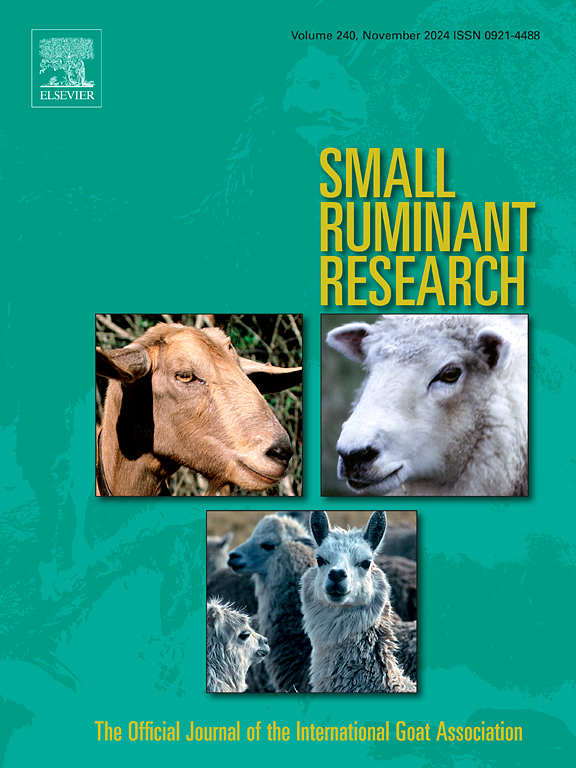Replacement of soybean meal with camelina meal in diet of fattening lambs: Influence on feed intake, performance and ruminal fermentation parameters
IF 1.4
3区 农林科学
Q2 AGRICULTURE, DAIRY & ANIMAL SCIENCE
引用次数: 0
Abstract
This study evaluated the effects of replacing soybean meal (SBM) with different levels of camelina meal (CM) on feed intake, growth performance, nutrient digestibility, ruminal fermentation, and estimated microbial nitrogen synthesis (EMNS) in fattening Grey Shirazi lambs. Thirty-two lambs (95.0 ± 10.0 days old; body weight of 28.5 ± 1.3 kg) were individually housed for 83 days. Experimental diets were Con (control, diet without CM), CM33 (diet containing 33 % DM of CM instead of SBM), CM66 (diet containing 66 % DM of CM instead of SBM) and CM100 (diet containing 100 % DM of CM instead of SBM). The DM, EE, NDFom, ADFom and ADL contents of CM were higher than in SBM and the ash, CP, NFC and ME contents were lower than those of SBM. There was a tendency for increased dry matter intake (DMI) and final BW in lambs nourished with the CM33 diet compared to the control diet (L = 0.053 and Q = 0.013 respectively). The highest values of gain and average daily gain (ADG) were observed in lambs consuming the CM33 diet (Q = 0.012 and Q = 0.0012). The 66 % CM diet enhanced feed conversion ratio (FCR) (Q = 0.041). Lambs fed the 33 % CM diet exhibited greater DM and OM digestibility than other groups (DM: L = 0.014, Q = 0.028; OM: L = 0.109, Q = 0.028). The pH, total VFA, butyrate, isobutyrate, valerate, and isovalerate levels did not differ between lambs fed SBM and different levels of CM (P > 0.05). No significant variation was detected in ruminal NH3-N production between lambs fed the CM33 or CM66 diets and those receiving the control diet. Lambs fed the 33 % CM diet showed a trend toward lower ruminal NH₃-N compared to those fed the control diet (L = 0.002, Q = 0.024). In lambs fed the 33 % CM diet, acetate concentration (C = 0.037), acetate:propionate ratio (C = 0.028), and methane production (C = 0.024) decreased, while propionate concentration increased (C = 0.022) compared to the control diet. Lambs receiving the CM33 diet exhibited a higher EMNS than those fed the control diet (Q = 0.038 and C = 0.011). Regarding SMB, CM inclusion at varying levels significantly diminished protozoal counts and subfamilies of Entodiniinae and Diplodiniinae (L < 0.0001). The population of Isotricha (L = 0.011) and the subfamily of Ophrioscolecinae (L = 0.002) decreased only in the CM100 diet compared to the control diet. This study demonstrates that CM can replace SBM up to 100 % of dietary DM in lamb diets without compromising performance, with 33 % inclusion yielding optimal improvements in efficiency and sustainability. These findings, coupled with camelina's agronomic advantages in water-limited conditions, suggest that CM represents a sustainable alternative to SBM in ruminant production systems.
饲粮中用亚麻荠粕替代豆粕对育肥羔羊采食量、生产性能和瘤胃发酵参数的影响
本试验研究了饲粮中添加不同水平的亚麻荠粕(CM)替代豆粕(SBM)对育肥羔羊采食量、生长性能、营养物质消化率、瘤胃发酵及微生物氮合成(EMNS)的影响。试验羔羊32只(95.0 ± 10.0日龄,体重28.5 ± 1.3 kg),单独饲养83 d。试验饲粮为Con(对照组,不含肉豆粕)、CM33(含33 %肉豆粕DM的饲粮)、CM66(含66 %肉豆粕DM的饲粮)和CM100(含100 %肉豆粕DM的饲粮)。CM的DM、EE、NDFom、ADFom和ADL含量高于SBM,灰分、CP、NFC和ME含量低于SBM。与对照饲粮相比,CM33饲粮有增加羔羊干物质采食量和最终体重的趋势(L = 0.053, Q = 0.013)。饲粮CM33的羔羊增重和平均日增重最高(Q = 0.012和Q = 0.0012)。66 % CM日粮提高饲料系数(FCR) (Q = 0.041)。饲粮中添加33% % CM的羔羊DM和OM的消化率高于其他各组(DM: L = 0.014, Q = 0.028; OM: L = 0.109, Q = 0.028)。饲饲不同水平的豆粕羔羊的pH、总VFA、丁酸、异丁酸、戊酸和异戊酸水平无显著差异(P >; 0.05)。饲喂CM33或CM66的羔羊与对照组羔羊瘤胃NH3-N产量无显著差异。饲粮中添加33% % CM的羔羊瘤胃NH₃-N显著低于对照组(L = 0.002, Q = 0.024)。饲粮中添加33 % CM的羔羊,与对照饲粮相比,乙酸浓度(C = 0.037)、乙酸丙酸比(C = 0.028)和甲烷产量(C = 0.024)降低,丙酸浓度(C = 0.022)升高。饲粮CM33组羔羊的EMNS高于对照组(Q = 0.038, C = 0.011)。对于SMB,不同水平的CM包涵显著减少了内托diniinae和双plodiniinae的原虫数量和亚科(L < 0.0001)。与对照日粮相比,CM100日粮中只有异头虫(L = 0.011)和Ophrioscolecinae亚科(L = 0.002)的种群数量减少。本研究表明,在不影响羔羊生产性能的情况下,CM可替代饲粮中高达100% %的DM,其中33% %的DM可获得最佳的效率和可持续性提高。这些发现,再加上亚麻荠在缺水条件下的农艺优势,表明在反刍动物生产系统中,亚麻荠是一种可持续的替代SBM的作物。
本文章由计算机程序翻译,如有差异,请以英文原文为准。
求助全文
约1分钟内获得全文
求助全文
来源期刊

Small Ruminant Research
农林科学-奶制品与动物科学
CiteScore
3.10
自引率
11.10%
发文量
210
审稿时长
12.5 weeks
期刊介绍:
Small Ruminant Research publishes original, basic and applied research articles, technical notes, and review articles on research relating to goats, sheep, deer, the New World camelids llama, alpaca, vicuna and guanaco, and the Old World camels.
Topics covered include nutrition, physiology, anatomy, genetics, microbiology, ethology, product technology, socio-economics, management, sustainability and environment, veterinary medicine and husbandry engineering.
 求助内容:
求助内容: 应助结果提醒方式:
应助结果提醒方式:


